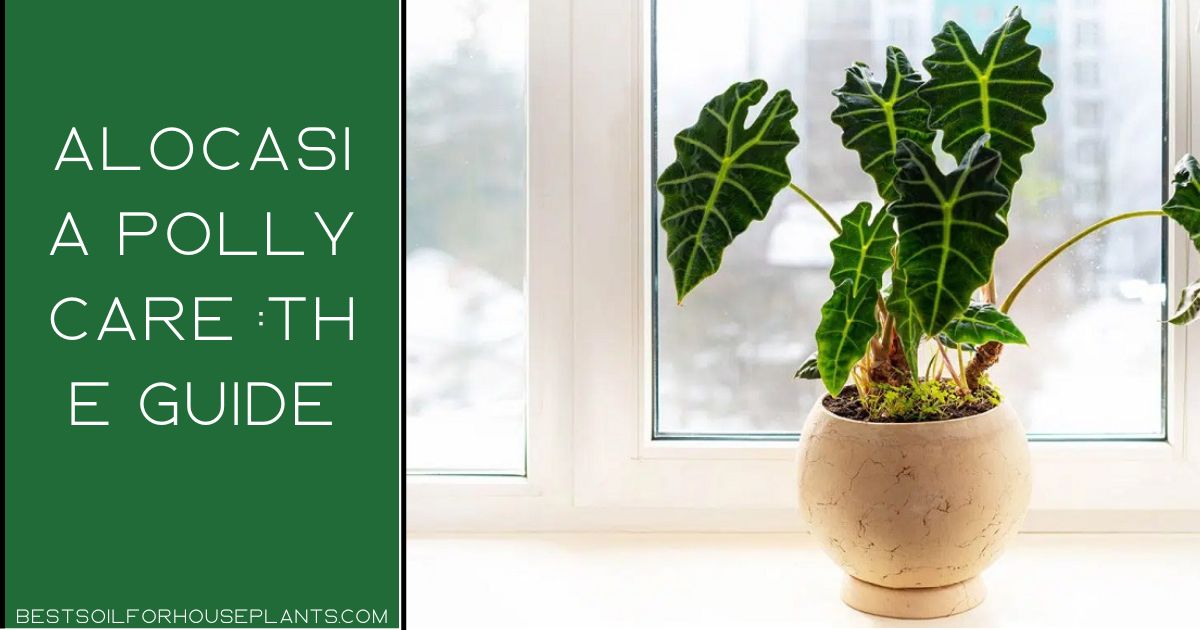Alocasia Polly, with its striking arrowhead leaves and vibrant green hues is a favorite among plant lovers. But to keep this tropical beauty thriving, getting the soil right is key. The unique needs of Alocasia Polly mean that typical potting soil just won’t cut it.
This comprehensive guide will explore everything you need to know about crafting the perfect soil mix for Alocasia Polly. We’ll dig into understanding its natural habitat, look at must-have soil ingredients and tackle common soil-related issues. With the right soil your Alocasia Polly will be happy and healthy for years to come.
Understanding Alocasia Polly’s Natural Environment
Alocasia Polly hails from the tropical rainforests of Southeast Asia, where conditions are warm, humid, and the soil is rich, moist, and acidic. In its natural habitat, Alocasia Polly thrives in the understory, receiving filtered sunlight and ample moisture with excellent drainage.
This gives us great clues about recreating ideal soil conditions at home. The goal is to provide a substrate that retains moisture while still draining well. Air circulation around the roots is also key, mimicking the airy, humus-rich soil of the rainforest floor.
Must-Have Soil Ingredients for Alocasia Polly
Creating the perfect soil mix for Alocasia Polly is easy with the right ingredients on hand. Here’s what you’ll need:
-
Peat moss – Helps soil hold moisture without getting waterlogged. Also contributes to a slightly acidic pH.
-
Perlite – Lightens the soil texture for improved drainage and aeration. Prevents compaction around roots.
-
Pine bark fines – Provide structure and help retain some moisture while boosting drainage.
-
Compost – Nutrient-rich organic matter to feed the plant and support healthy soil.
Mixing the Ideal Soil Blend
Combining peat moss, perlite, pine bark fines, and compost creates the ideal lightweight and fluffy texture Alocasia Polly requires. Aim for equal parts of each ingredient for a perfectly balanced mix.
Thoroughly blend the components in a large container to distribute evenly. The resulting soil should feel like a moist, springy sponge that retains just the right amount of moisture while draining rapidly.
Essential Repotting Tips
Repotting into fresh soil allows you to check Alocasia Polly’s root health while providing ideal growing conditions. Follow these tips for repotting success:
- Repot in spring or early summer when the plant is actively growing.
- Choose a pot 2 inches wider than the current container.
- Ensure pots have drainage holes to prevent soggy soil.
- Loosen tangled roots and remove any that are dead or rotten.
- Place the plant in new pot and backfill with your custom soil mix.
- Water thoroughly after repotting to help settle the roots.
Avoiding Common Soil Problems
Even with the perfect soil blend, issues can pop up. Monitor your plant and soil closely to catch problems early.
Overwatering – Allow soil to partially dry out between waterings. Leaves yellowing? Check for rotten roots.
Underwatering – Leaves crisp and dry? Water more frequently and consider adding extra peat moss to your mix.
Nutrient deficiency – Stunted growth and pale leaves likely indicate a need for fertilizer.
Compacted soil – Prevent by incorporating perlite and bark fines. Gently loosen overly dense soil.
Maintaining Ideal Soil Over Time
Continued care will keep your custom soil mix in peak condition:
-
Check for compaction and loosen soil as needed.
-
Replace the top 1-2 inches of soil annually.
-
Look for signs of pests like fungus gnats.
-
Use rain or filtered water to avoid minerals.
-
Test and amend pH as needed to stay between 5.5-6.5.
Key Takeaways
-
Alocasia Polly prefers a well-aerated, moist but not soggy soil with a slightly acidic pH.
-
Create a custom blend using peat moss, perlite, pine bark fines, and compost.
-
Pot in a container with drainage holes and repot every 2-3 years.
-
Monitor soil moisture closely and avoid overwatering.
-
Maintain soil structure and nutrient levels with regular care.
With the right soil mix and attentive care, your Alocasia Polly will thrive indoors for years to come! Let this tropical beauty brighten your home with its vibrant arrowhead leaves.

⏰ Choosing the Right Moment
Timing is everything. Spring or early summer is ideal for repotting, as the plant is in its growth phase and can recover more swiftly from any stress.
Selecting the Pot
Go for a new pot thats about 2 inches wider than the current one. Oversized pots are a no-go—theyre like empty echo chambers for roots, making the soil dry out at a snails pace.
Pon vs Fluval Stratum for Alocasia Growth!
FAQ
What kind of soil does Alocasia Polly like?
Soil and Potting: Alocasia Polly prefers well-draining soil that retains some moisture. Use a high-quality, well-aerated potting mix specifically designed for tropical plants. You can create a suitable mix by combining equal parts of peat moss, perlite, and potting soil.
What is the best soil mixture for Alocasia?
Alocasias appreciate soil mixes that are airy and well-draining. A chunky soil mix designed for aroids is ideal. Typically, mixing together regular potting mix, orchid bark/orchid bark mix, perlite, and peat moss/coco coir makes a great potting mixture for an Alocasia frydek.
What’s the best substrate for Alocasia?
Organic matter such as coco coir or peat moss provides the necessary moisture retention, while perlite or orchid bark ensures proper drainage.Jun 17, 2024
What’s the best soil for elephant ear plants?
Soil: Grow elephant ears in moist, loamy soil with a high organic matter content. Spacing: Spacing depends on the variety you’re growing. You could need anywhere from 2 feet to 6 feet between plants to allow them enough room to spread out.
